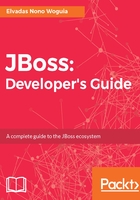
上QQ阅读APP看书,第一时间看更新
Starting the domain
We now have a domain controller ready, and also have an administration user and two hosts with proper settings to interact with the primary domain controller. Let's start the domain controller and the hosts:
bin$ ./domain.sh -Djboss.domain.base.dir=../../host0/domain/ --host-config=host-master.xml
Start host1 from one tab of your terminal:
./domain.sh -Djboss.domain.base.dir=../../host1/domain/ --host-config=host-slave.xml
From another tab of your terminal, start host2:
./domain.sh -Djboss.domain.base.dir=../../host2/domain/ --host-config=host-slave.xml
You can see the host registering in domain controller logs:
[Host Controller] 11:25:50,519 INFO [org.jboss.as.domain.controller] (Host Controller Service Threads - 36) WFLYHC0019: Registered remote slave host "host1", JBoss JBoss EAP 7.0.0[Host Controller] 11:28:06,670 INFO [org.jboss.as.domain.controller] (Host Controller Service Threads - 37) WFLYHC0019: Registered remote slave host "host2", JBoss JBoss EAP 7.0.0
Let's connect to the domain controller:
http://127.0.0.1:9990/console
login :admin, Password : Admin01#.
You can see Hosts that are members of the domain:

EAP domain console
This concludes the first part of this lab, where we set up a simple domain with one primary domain controller and two slave hosts. In the subsequent steps, we will see how to use the JBoss Command-Line Interface (CLI) to read and edit the configuration.